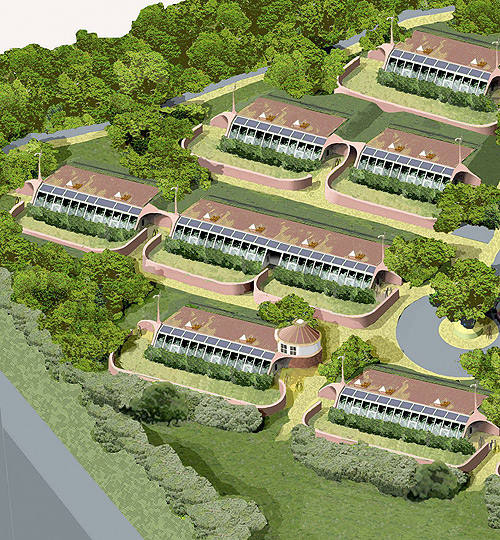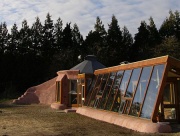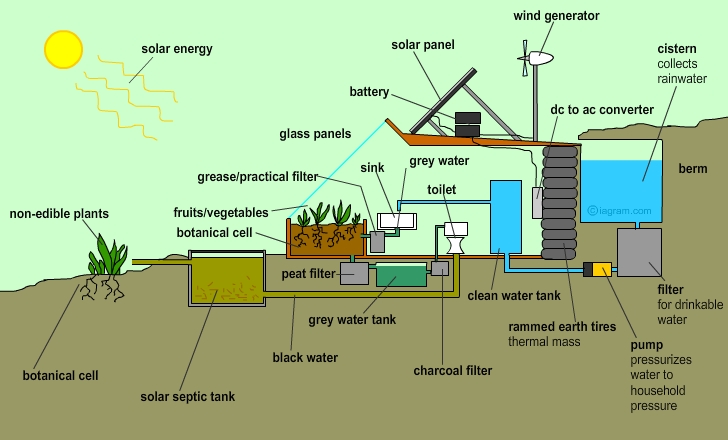Team:Habitation/Habitation Low Density
Contents |
Low density habitation
A simple way to build a sustainable village is using earth-ships. These are essentially of-the-grid houses combining all elements of power generation, heating and water in one house. This has the supplementary advantage of not needing any infrastructure of power, water and waste distribution. But a house like this needs enough room for receiving sunlight and other integrated system including the plants needed to process the waste water. Therefor the infrastructure will resemble a classic rural village.
Because of this layout the distances between houses and workplaces (for recycling and fabrication probably) are a sometimes a bit big for walking so cycling is a must as cars too energy intensive. What is possible is the use of small golf-cars or small electric scooters.
Earthships
What is it
An earthship is a dwelling designed for of the grid living. It is designed are maximized to
- needs only the sun for heating
- natural air flows for cooling
- capture, filter and reuses rain so no additional water supply is needed
- use solar, wind and batteries to provide enough electricity continuously
- build in green house to provide an amount of food
- build using recycled materials
The inventor, Michael Reynolds, has a site earthship.com
How it works
The house ifself is partly dug into the ground with south facing windows. The windows are placed at an angle so that in the summer the sun doesn't shine into the house itself but only in the greenhouse at the front of the house. In the winter however the sun reaches the inner rooms to provide heat. To retain that heat for during the evening and night, the outer walls of the house are build with rammed earth tires inside a thermal wrap to serve as a heavy thermal mass. It retains the heat of the day and slowly releases it during the night. Actively heating the house becomes (largely) unneccesary.
For cooling there are often air ducts in the earth or passing the water tank to take in cold air. Warm air exits the house by using a window or trap that can be opened on the roof. This natural air circulation cools down the house. The placing of the windows keeps most of the sun out of the house so addictional cooling is not required.
The roof functions as a rain collector and guides the water into the cistern. The water from this cistern is filtered to make the water fit drinkable. The water from the sink and shower is fed to the greenhouse. The plants and other filters make the water usable for the toilet. The remains of the toilet are fed to the septic tank and the water overflow from the septic tank is used in the botanic cell to filter the water for the last time. In most climates the rain with the cistern provides enough water to maintain a normal lifestyle without having a water connection.
Photovoltaic panels are used to generate electricity and to recharge the battery pack that provides the energy for everning and night. Other solar panels are used to heat the water. This provides enough energy so there is no need for a connection to the power grid. As there is a greenhouse build into the house that is watered by the systems, it can be used to grow food.
How it's build
The walls are build using a lot recycled materials. Tires filled with rammed sand are used for the walls for thermal mass. Aluminium cans are often used instead of bricks. Often glass bottles are build into the wall so there is natural light in the house and less electricity is needed. The rest of the wall is cement or abode to keep it all together. It also gives a more alternative and organic feel to the house. This makes the house cheaper to build. Most of the other structures are build with wood.
The house itself is cheap in materials but takes a substantial amount of man-hours to put it together and install all the systems.
Where can it be used
This concept is used in desert climat, tropical and moderate climat and seems to work with some modifications. Ideally the houses are build into the southern side of a hill so all houses receive sufficiently sunshine.


